Beef Tenderloin with Red Wine Sauce
- By Jennifer Segal
- November 29, 2024
- 1,358 Comments
- Leave a Review

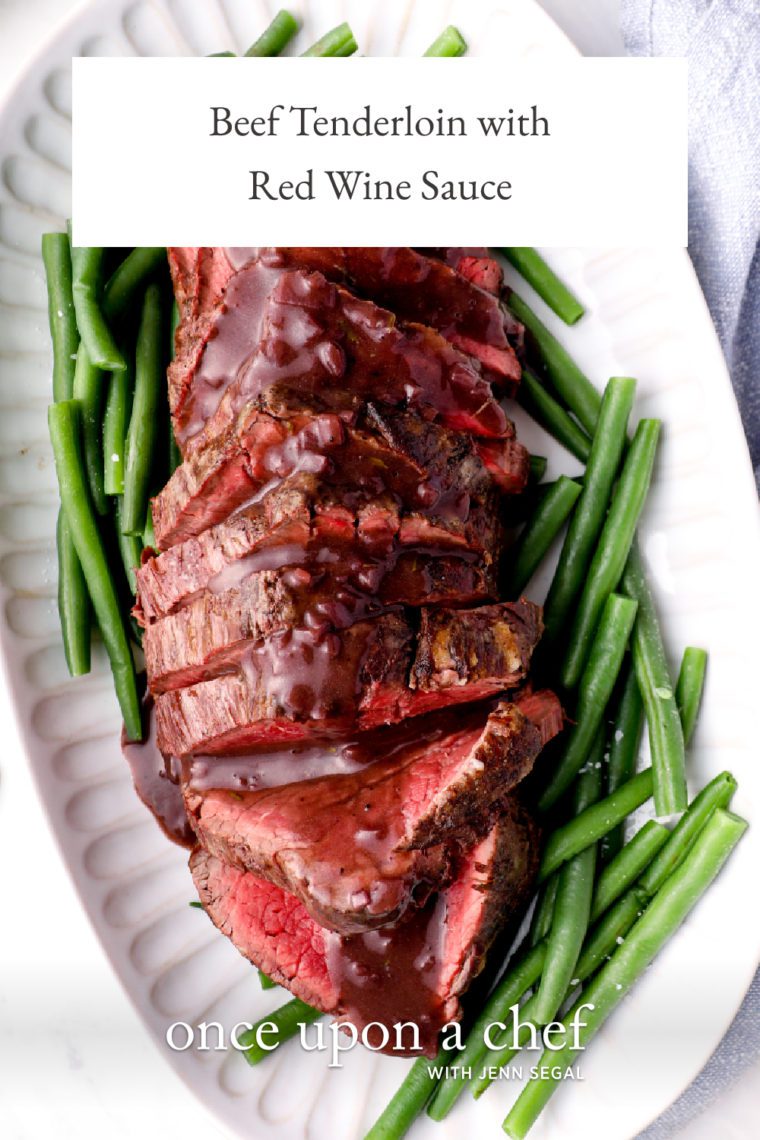
This post may contain affiliate links. Read my full disclosure policy.
This beef tenderloin looks fancy, but it couldn’t be easier to make. It cooks up perfectly every time, and the rich red wine sauce takes it over the top. A total showstopper for any special dinner.
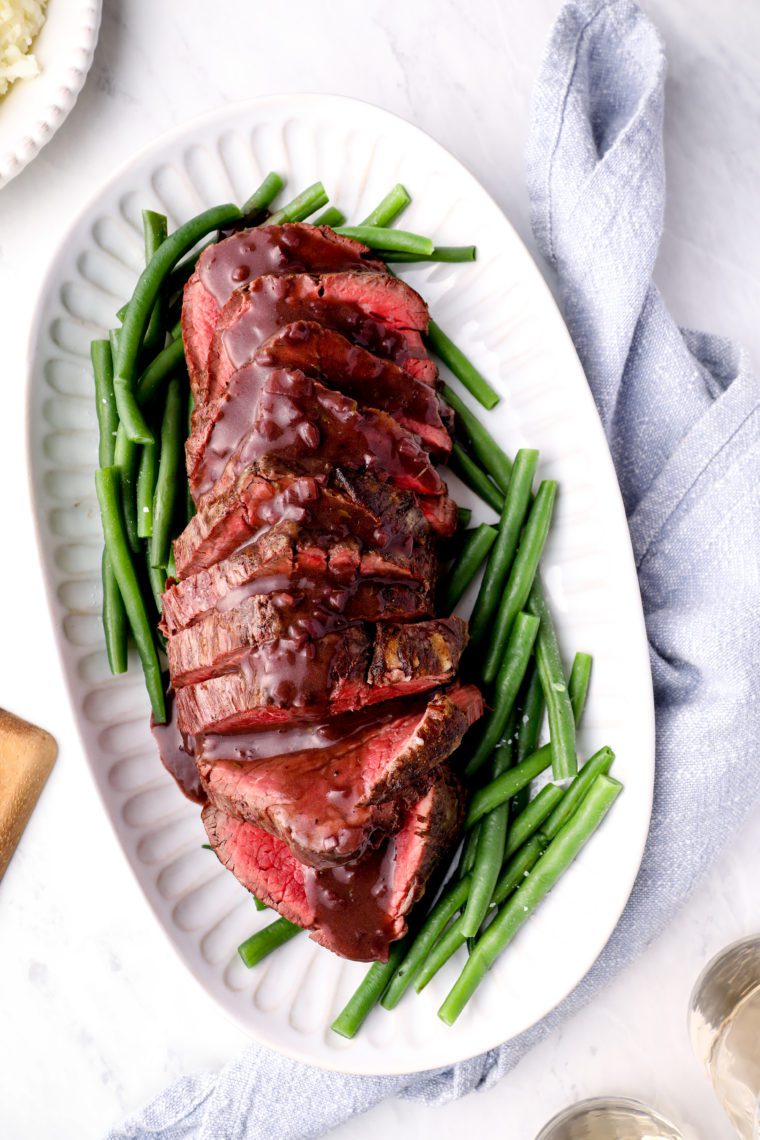
This beef tenderloin recipe is my #1 go-to for holidays and special occasions. It never fails to impress, and my foolproof method ensures perfectly cooked beef every time, with no guesswork! The tenderloin is paired with a red wine reduction sauce—made by simmering wine, broth, and aromatics until the flavors concentrate, then finished with butter for a silky, gorgeous sauce that rivals anything you’d order at a fine restaurant—yes, it’s fancy!
A great bonus is that the sauce can be prepared mostly in advance, so there’s very little fussing at the last minute. Similar to my pork tenderloin, this recipe is truly the best of both worlds: simple to prepare yet incredibly delicious.
“Voted best Christmas dinner ever!”
What You’ll Need To Make Beef Tenderloin with Red Wine Sauce
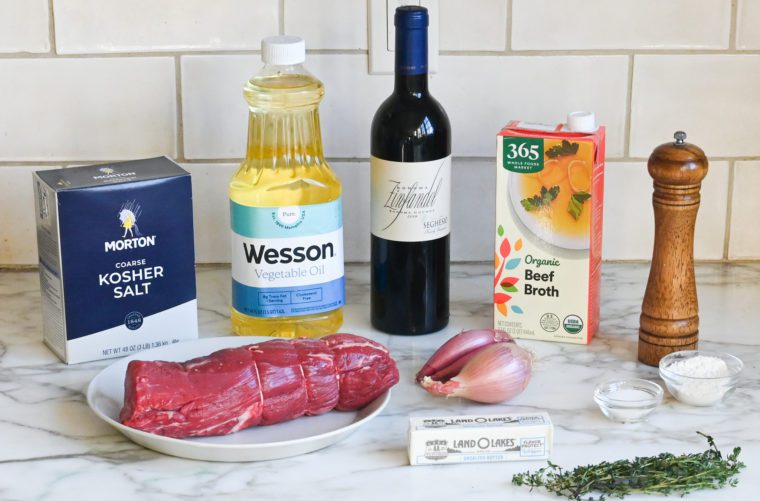
- Beef tenderloin: The most tender and expensive cut of beef, this is the whole piece before it’s sliced into steaks, which are known as filet mignon (great for recipes like steak au poivre or pan-seared steaks). As a general rule, plan for about ½ pound per person for a generous serving. Your tenderloin may be tied with butcher’s twine near the tapered end to keep it evenly thick; leave the string on until after it is cooked. If it’s not tied, no worries—no tying is necessary.
- Butter: A portion is used for sautéing shallots, while the rest is combined with flour to create a beurre manié, which thickens the sauce.
- Shallots: Adds a mild onion flavor to the sauce.
- Red wine: Adds rich, fruity flavors and depth of color to the sauce. Any variety, such as Merlot, Pinot Noir, Cabernet Sauvignon, Syrah, or Red Zinfandel, will work. When cooking with wine, choose an inexpensive bottle that’s still enjoyable to drink. Avoid supermarket “cooking wines,” which often contain salt and additives.
- Beef broth: Provides a savory base for the sauce; also used to deglaze the pan after roasting the beef.
- Thyme sprigs: Adds earthy, aromatic flavor to the sauce.
- All-purpose flour: Mixed with butter to create a beurre manié, a thickening agent for the sauce.
- Jump to the printable recipe for precise measurements
Step-by-Step Instructions
Make the Sauce: Melt the butter in a saucepan and cook the shallots over medium-low heat until soft. Add the wine, broth, thyme, salt, pepper, and sugar, then bring to a boil. Simmer for 30 minutes until reduced by half. In a small bowl, mix a few more tablespoons butter with flour to form a paste. Gradually whisk the paste into the sauce and simmer until thickened. The sauce can be made a few days ahead up to this point.

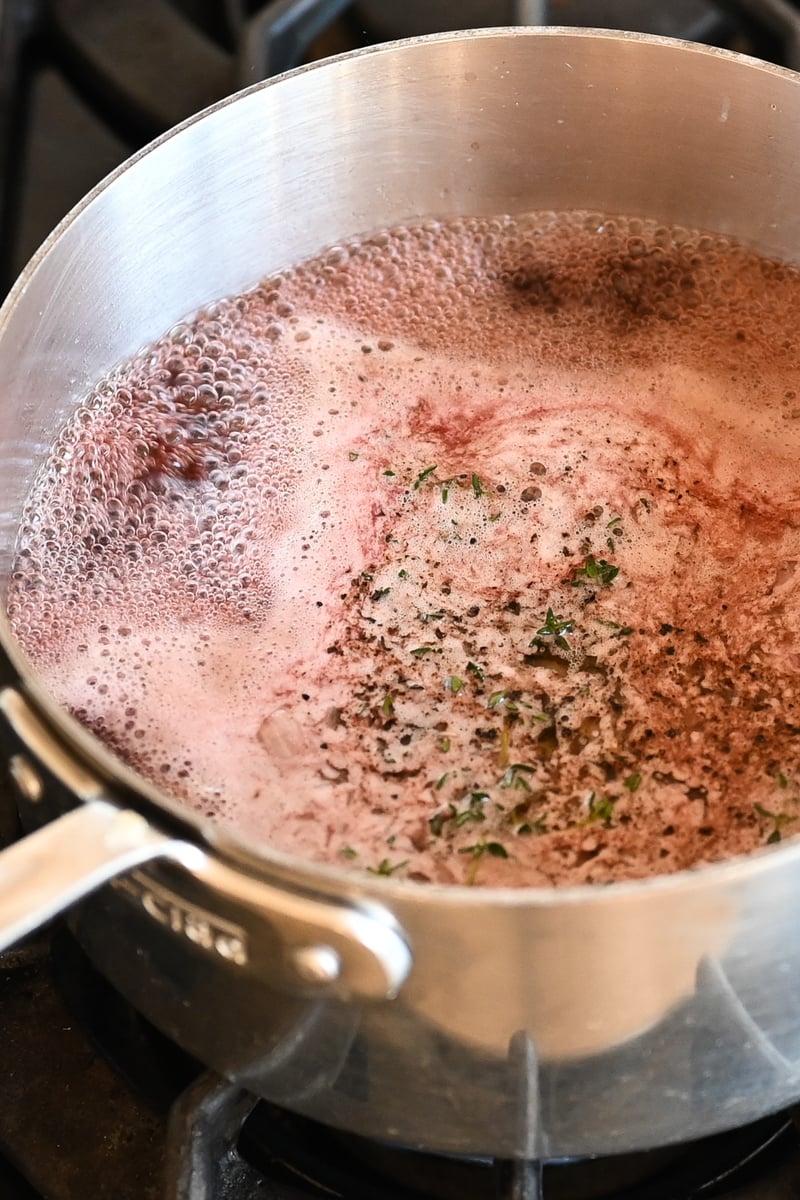


Sear & Roast the Beef Tenderloin: Season the beef with kosher salt and freshly ground black pepper. Don’t be shy with the seasoning; it needs a lot!

Heat the oil in an oven-proof skillet over medium-high heat until almost smoking. Cook until well browned with a nice crust on all but one side. Turn the tenderloin so that the un-seared side is down and transfer the skillet directly to a 400°F oven. I recommend using a leave-in meat thermometer with a remote monitor to keep an eye on the roast. These are ideal for cooking pricey cuts like tenderloin (they’re great for other dishes too, like turkey).

Roast until cooked to your liking, keeping in mind that the the internal temperature will continue to rise 5 to 10 degrees after being removed from the oven—this is known as carryover cooking.
Rare: 115°F-120°F
Medium Rare: 120°F-125°F
Medium: 130°F-135°F
Medium-Well: 140°F-145°F
Well Done: 150°F and above
Finish the Sauce and Carve the Beef: Set the pan on the stovetop, add the broth, and bring to a boil, deglazing by scraping up the brown bits with a wooden spoon. Add this flavorful broth to the wine sauce and bring it to a simmer.

Carve the roast into slices and serve, passing the red wine sauce at the table. The tenderloin is wonderful served over mashed potatoes with a simple vegetable, like French green beans or roasted Brussels sprouts.

You May Also Like
Beef Tenderloin with Red Wine Sauce
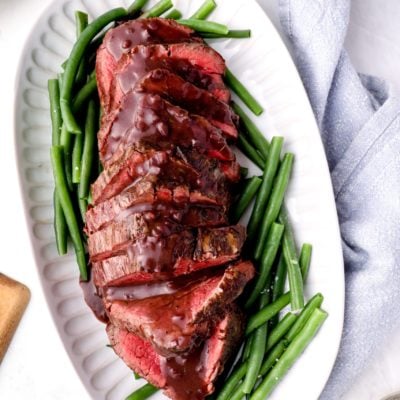
Ingredients
For the Sauce
- 8 tablespoons unsalted butter, divided
- ¾ cup finely chopped shallots, from 2 to 3 large shallots
- 1¼ cups red wine
- 3 cups beef broth
- 6 fresh thyme sprigs
- ¼ teaspoon kosher salt
- ⅛ teaspoon freshly ground black pepper
- 1 teaspoon sugar
- 2 tablespoons all-purpose flour
For the Beef
- 1 (2 to 3 lb) center-cut beef tenderloin roast
- Kosher salt (½ teaspoon per pound of beef)
- Freshly ground black pepper (¼ teaspoon per pound of beef)
- 2 tablespoons vegetable oil
- ¼ cup beef broth
Instructions
For the Sauce
- Melt 5 tablespoons of the butter in a medium saucepan. Add the shallots and cook over medium-low heat, stirring occasionally, until soft and translucent, 7 to 8 minutes. Add the wine, beef broth, thyme sprigs, salt, pepper and sugar, and bring to a boil. Cook over medium heat for about 30 minutes, or until the liquid is reduced by about half.
- While the liquid is reducing, place the remaining 3 tablespoons of butter in a small bowl and soften in the microwave, if necessary (it should be soft but not melted). Add the flour and, using a small spoon, mix into a smooth paste.
- Once the wine mixture is reduced, reduce the heat to low and remove the thyme sprigs. Whisk the flour-butter paste, a tablespoon at a time, into the simmering liquid, and simmer for a few minutes, until the sauce is thickened. Set aside. (The sauce can be made up to this point and refrigerated up to 3 days ahead of time.)
For the Tenderloin
- Let the beef stand at room temperature for 1 hour before roasting. Set an oven rack in the middle position and preheat the oven to 400°F (205°C).
- Season the beef all over with kosher salt and pepper. Heat the oil in an oven-proof skillet over medium-high heat until almost smoking. Cook, turning with tongs, until well browned on all but one side, about 10 minutes total. Turn the tenderloin so that the un-seared side is down, and transfer the skillet directly to the preheated oven. (If your pan isn't oven-proof, transfer the beef to a lightly oiled roasting pan.) Roast until a thermometer inserted into the center of the meat registers 120°F to 125° (49°C to 52°C) for medium rare, about 15 minutes, or until done to your liking (115°F to 120°F/46°C to 49°C for rare, 130°F to 135°F/54°C to 57°C for medium). Keep in mind that these temperatures account for the fact that the temperature will continue to rise about 5 degrees while the meat rests.
- Transfer the meat to a carving board (preferably with a well for collecting juices) and let it rest, covered loosely with aluminum foil, for 10 to 15 minutes. Place a dishtowel or oven mitt over the handle of the roasting pan to remind yourself that it's hot.
- Meanwhile, carefully discard the fat from the roasting pan (remember that the handle is hot!). Set the pan on the stovetop and add the ¼ cup (60 ml) of broth. Bring the broth to a boil and, using a wooden spoon, scrape the fond, or brown bits, from the bottom of the pan. Add the flavorful broth to the red wine sauce, and then bring the sauce to a simmer.
- Carve the tenderloin into ½-inch (13-mm) thick slices. Serve the beef, passing the red wine sauce at the table.
Pair with
Nutrition Information
This website is written and produced for informational purposes only. I am not a certified nutritionist and the nutritional data on this site has not been evaluated or approved by a nutritionist or the Food and Drug Administration. Nutritional information is offered as a courtesy and should not be construed as a guarantee. The data is calculated through an online nutritional calculator, Edamam.com. Although I do my best to provide accurate nutritional information, these figures should be considered estimates only. Varying factors such as product types or brands purchased, natural fluctuations in fresh produce, and the way ingredients are processed change the effective nutritional information in any given recipe. Furthermore, different online calculators provide different results depending on their own nutrition fact sources and algorithms. To obtain the most accurate nutritional information in a given recipe, you should calculate the nutritional information with the actual ingredients used in your recipe, using your preferred nutrition calculator.
See more recipes:
Comments
Add a Comment Cancel reply
This site uses Akismet to reduce spam. Learn how your comment data is processed.
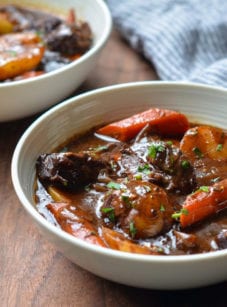
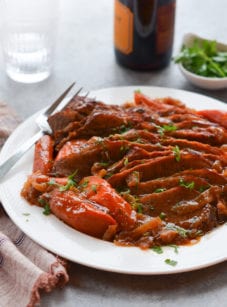



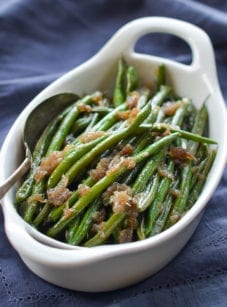

What type red wine do you use for the sauce. Pinot Noir, Carbernet, Merlot, etc? I am not a red wine drinker so I do not know the differences. I am making your recipe for the first time this Christmas. Thanks!
Hi Sharon, You can use any of those options—it won’t make much of a difference at all since you’re cooking it down so much. No need to splurge on a pricey bottle—something in the $10-$15 range is fine; just avoid supermarket “cooking wines.” Hope that helps!
It does. Thank you. Merry Christmas!!
I am going to cook enough for 15 people. Can I put both roasts in the same oven? How much does it change the cooking time?
Hi Patricia, Yes that’s fine and the cook time should be about the same—maybe just a bit longer.
I am opening a nice red wine tomorrow to make your beef stew. I would like to use the remainder for making the red wine sauce for Christmas tenderloin. I don’t know if I should make the sauce tomorrow, freeze and thaw it on the 24th or will the wine still be good on 12/25?
Hi Mimi, The wine will still be fine to use on 12/25. Enjoy!
Great! The family always flip out over how amazing the house smells when they arrive and the sauce is simmering.
can I make the au gratin potatoes and put them in the warmer while I make your asparagus in the oven ? Thanks so much !!
Sure, that should be fine.
Hello.
I have a 6-1/2 pound tenderloin and I’m feeding 7 adults. Should I double the sauce recipe and allow for extra time for the tenderloin? Thanks
Anthony
Hi Anthony, For a 6-1/2 pound tenderloin, the cook time will be a little longer, but not by much. I’d use a meat thermometer so there’s no guesswork involved. And, yes, I’d double the sauce. Hope everyone enjoys!
Hello Jenn-i’ve seen other recipes for roasts that season with kosher salt and place in refrigerator for 24 hours before cooking. Something to do with the malliard (?) effect. Just wondering what your thoughts are on this for a tenderloin roast recipe. I trust your judgement and expertise- that’s why I’m asking. Thank you for sharing all your delicious recipes!
Hi Lynn! Thanks so much for your kind words! The technique you’re referring to involves salting the meat and letting it sit in the fridge, which helps retain juiciness and enhances flavor. It also dries out the surface, creating a nice crust when cooking. I use this method for my dry-brine turkey. It’s a great technique if you have time (and fridge space), but it’s not necessary for this recipe, especially with the flavorful sauce. Hope that helps!
How can I get the flavor from searing the tenderloin if I sous-vide and finish my meat on the grill?? To make the red wine sauce?
Hi Cindy, Unfortunately I don’t think there’s any way to replicate the same flavor, but you can add any juices that accumulate while the beef is resting to the sauce; that should help.
Hi Jenn. Have made your beef tenderloin recipe many times with wonderful results
Was wondering if after beef is cooked to your desired preference and rested can it be sliced and kept on warm in crock pot with some of the gravy for about an hour? I’m thinking shouldn’t raise temp of meat if on low warm for short time
Hi Bonnie, I think it should be okay, but definitely keep an eye on it.
Thinking of making this for Christmas. We like our meat more on the med well to well done side (just a little pink in the center) so what temperature should I cook it to? Thank you
Hi Mary, for medium-well, roast the meat until an instant-read thermometer inserted into the center of the meat registers 145° – 150°. It definitely will be a bit drier if cooked that long, but still tasty.
Don’t for get it will still cook after you take it out of the oven…remember it should rest 10-15 minutes.
I will be doing two 3 1/2 pound roasts so I will have to transfer them to a roasting pan after I sear them in a skillet. My question is … isn’t that where some of the flavor remains? Or will I have enough in the roasting pan to add to the sauce? Does this make sense? And should it be a roasting pan or baking sheet?
Hi Cindy, that’s a good point – I’d use a roasting pan and I’d deglaze both the skillet and the roasting pan to get the most flavor for the sauce. Hope you enjoy!
Thanks for your quick reply. Here’s another question. Is it worth splurging on “prime” or is “choice” fine.
Of course! Choice is perfectly fine with tenderloin – when I worked in a fine dining steakhouse, we actually used choice for tenderloin because prime can be too lean for that particular cut.
Thank you so much for the recipe, I cooked it last year around Christmas, it was by far the best roast I have ever tasted in my life. My brother-in-law just talked about it last night, how wonderful it was. So I searched for it again!thanks so much five stars for me for sure